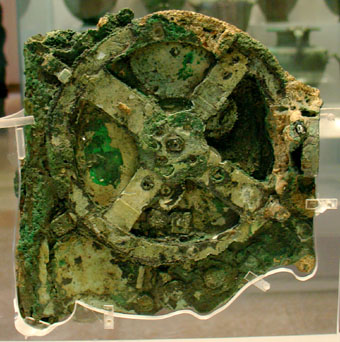 Just a quick note today to let you know about a conference that's coming up on the Antikythera mechanism. It's open to the public and it's being held in Cambridge on 6 February (more details here). The speakers include Mike Edmunds and Tony Freeth, who headed the latest team to image the fragments of the Antikythera mechanism, as well as Yanis Bitsakis and Alexander Jones, who both helped to read the inscriptions that were revealed. Because it's a public meeting I don't know if they'll be giving away any as-yet unpublished secrets, but it should be a wonderful opportunity to hear about the latest work on this fascinating device, from the researchers who carried it out. I'll certainly be there, so I'll post about it afterwards, but I imagine they'll be focusing on their most recent paper, published in Nature last July. In it they reported that the mechanism had a 4-year dial on it that showed the timing of the Panhellenic Games, including the Olympic Games, as well as a local calendar which hinted that the mechanism might have come from Syracuse, on the island of Sicily in the western Mediterranean. This was a huge surprise because all the indications from the shipwreck on which the mechanism was found suggested that it came from somewhere much further east, perhaps Rhodes. (See this news story I wrote about it at the time for New Scientist, or my more recent feature.)
Just a quick note today to let you know about a conference that's coming up on the Antikythera mechanism. It's open to the public and it's being held in Cambridge on 6 February (more details here). The speakers include Mike Edmunds and Tony Freeth, who headed the latest team to image the fragments of the Antikythera mechanism, as well as Yanis Bitsakis and Alexander Jones, who both helped to read the inscriptions that were revealed. Because it's a public meeting I don't know if they'll be giving away any as-yet unpublished secrets, but it should be a wonderful opportunity to hear about the latest work on this fascinating device, from the researchers who carried it out. I'll certainly be there, so I'll post about it afterwards, but I imagine they'll be focusing on their most recent paper, published in Nature last July. In it they reported that the mechanism had a 4-year dial on it that showed the timing of the Panhellenic Games, including the Olympic Games, as well as a local calendar which hinted that the mechanism might have come from Syracuse, on the island of Sicily in the western Mediterranean. This was a huge surprise because all the indications from the shipwreck on which the mechanism was found suggested that it came from somewhere much further east, perhaps Rhodes. (See this news story I wrote about it at the time for New Scientist, or my more recent feature.)
If you can't make it on the day, there's also an associated exhibition dedicated to the Antikythera mechanism, at Cambridge's Whipple Museum of the History of Science until spring 2009. The mechanism itself is on display in the National Archaeological Museum in Athens, but the exhibition has information about the latest research by Tony Freeth's team, as well as this beautifully-made video.